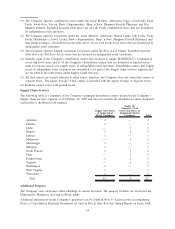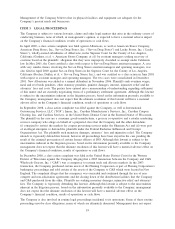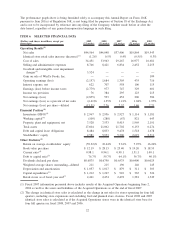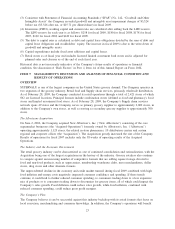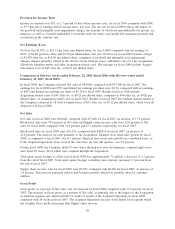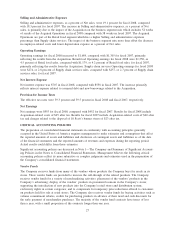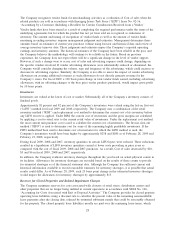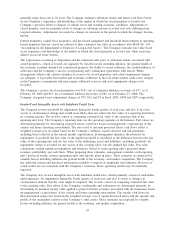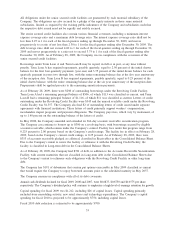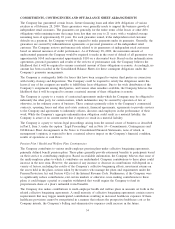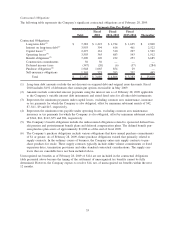Albertsons 2009 Annual Report Download - page 31
Download and view the complete annual report
Please find page 31 of the 2009 Albertsons annual report below. You can navigate through the pages in the report by either clicking on the pages listed below, or by using the keyword search tool below to find specific information within the annual report.Selling and Administrative Expenses
Selling and administrative expenses, as a percent of Net sales, were 19.1 percent for fiscal 2008, compared
with 18.3 percent for fiscal 2007. The increase in Selling and administrative expenses, as a percent of Net
sales, is primarily due to the impact of the Acquisition on the business segment mix which includes 52 weeks
of results of the Acquired Operations in fiscal 2008 compared with 38 weeks in fiscal 2007. The Acquired
Operations are part of the Retail food segment which has a higher Selling and administrative expenses
percentage than Supply chain services. The impact of the business segment mix more than offset the decrease
in employee-related costs and lower depreciation expense as a percent of Net sales.
Operating Earnings
Operating earnings for fiscal 2008 increased to $1,684, compared with $1,305 for fiscal 2007, primarily
reflecting the results from the Acquisition. Retail food Operating earnings for fiscal 2008 were $1,550, or
4.5 percent of Retail food sales, compared with $1,179, or 4.2 percent of Retail food sales, for fiscal 2007,
primarily reflecting the results from the Acquisition. Supply chain services Operating earnings for fiscal 2008
were $274, or 2.8 percent of Supply chain services sales, compared with $257, or 2.7 percent of Supply chain
services sales, for fiscal 2007.
Net Interest Expense
Net interest expense was $707 in fiscal 2008, compared with $558 in fiscal 2007. The increase primarily
reflects interest expense related to assumed debt and new borrowings related to the Acquisition.
Provision for Income Taxes
The effective tax rates were 39.3 percent and 39.5 percent in fiscal 2008 and fiscal 2007, respectively.
Net Earnings
Net earnings were $593 for fiscal 2008, compared with $452 for fiscal 2007. Results for fiscal 2008 include
Acquisition-related costs of $45 after tax. Results for fiscal 2007 include Acquisition-related costs of $40 after
tax and charges related to the disposal of 18 Scott’s banner stores of $23 after tax.
CRITICAL ACCOUNTING POLICIES
The preparation of consolidated financial statements in conformity with accounting principles generally
accepted in the United States of America requires management to make estimates and assumptions that affect
the reported amounts of assets and liabilities and disclosure of contingent assets and liabilities as of the date
of the financial statements and the reported amounts of revenues and expenses during the reporting period.
Actual results could differ from those estimates.
Significant accounting policies are discussed in Note 1—The Company and Summary of Significant Account-
ing Policies in the Notes to Consolidated Financial Statements. Management believes the following critical
accounting policies reflect its more subjective or complex judgments and estimates used in the preparation of
the Company’s consolidated financial statements.
Vendor Funds
The Company receives funds from many of the vendors whose products the Company buys for resale in its
stores. These vendor funds are provided to increase the sell-through of the related products. The Company
receives vendor funds for a variety of merchandising activities: placement of the vendors’ products in the
Company’s advertising; display of the vendors’ products in prominent locations in the Company’s stores;
supporting the introduction of new products into the Company’s retail stores and distribution system;
exclusivity rights in certain categories; and to compensate for temporary price reductions offered to customers
on products held for sale at retail stores. The Company also receives vendor funds for buying activities such as
volume commitment rebates, credits for purchasing products in advance of their need and cash discounts for
the early payment of merchandise purchases. The majority of the vendor fund contracts have terms of less
than a year, with a small proportion of the contracts longer than one year.
27



